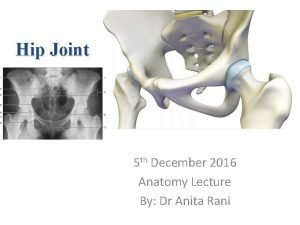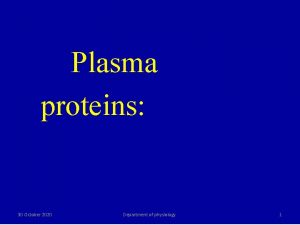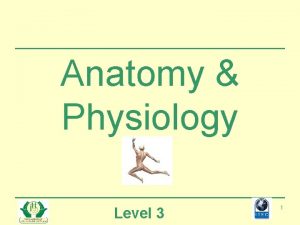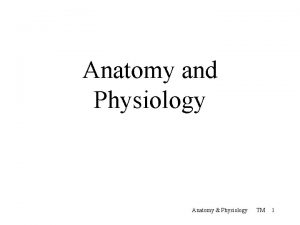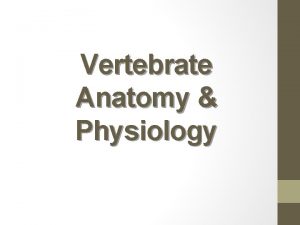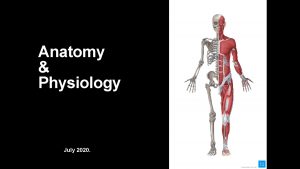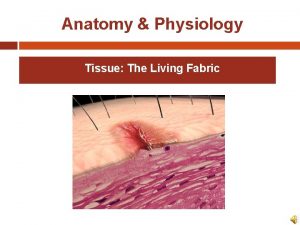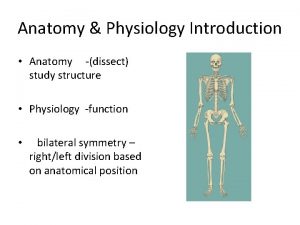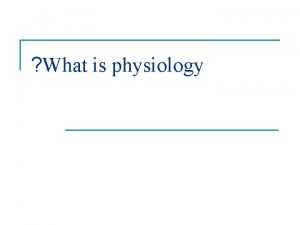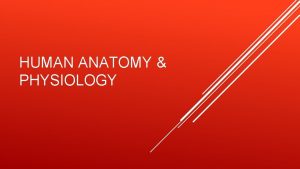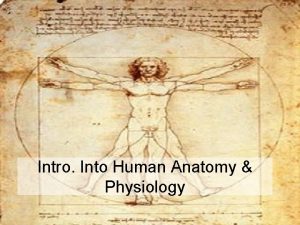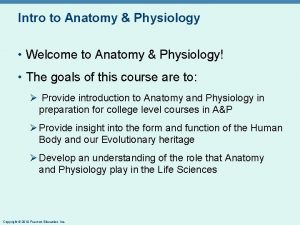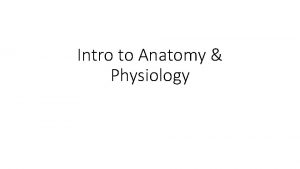Section A Applied Anatomy and Physiology 2 Joint



























- Slides: 27

Section A: Applied Anatomy and Physiology 2. Joint type

Syllabus • Definitions and examples of fibrous, cartilaginous and synovial joints • The typical structure and features of a synovial joint • The type of join and the bones which articulate at the following joints: – Shoulder, elbow, radio-ulnar, wrist, hip, knee, ankle, spine

Joint Classification • Structural classification is based on anatomical characteristics. • Fibrous: no synovial cavity and bones are held together by fibrous connective tissue. • Cartilaginous: no synovial cavity and the bones are held together by cartilage. • Synovial: bones forming the joint have a synovial cavity. Held together by the articular capsule and often by accessory ligaments.

Fibrous Joint (Suture) * the amount of movement is based on the length of the tissue fibres *

Fibrous Joint (Syndesmosis)

Cartilaginous Joint Types • (Synchondroses) – temporary joints present in children – E. g. epiphyseal plates in long bones • (Sympheses) – permanent cartilaginous joints – E. g. vertebral column

Temporary Joint

Permanent Joint

Synovial Joints • There are 6 types • These are categorized according to range of movement possible • Movement determined by: – Shape of articulating surfaces – Position of ligaments – Number of ligaments


Synovial Joint Features • Common features include – A joint (articular) capsule: unites the articulating bones. – A joint cavity. – A synovial membrane: secretes synovial fluid to reduce friction/absorb shock, supply nutrients. – Articular (hyaline) cartilage.

Some Synovial Joints Also Have… • Bursae – Small sacs of synovial fluid located at points of friction • Menisci – Discs of cartilage between bone surfaces • Pads of fat – Added protection


Synovial Joints

Synovial Joints

Ball and Socket

Ball and Socket Joint • Multiaxial • Movement in all 3 planes • • Flexion/Extension Abduction/Adduction Circumduction Rotation

Hinge

Hinge Joint • Uniaxial • Only permits flexion and extension • Examples are the knee, elbow and ankle

Pivot

Pivot Joints • Uniaxial • It allows rotation only around its own longitudinal axis • Example is the atlanto-axial joint

Plane

Planar Joints • Nonaxial • The motion they allow does not occur around an axis or along a plane • Examples are intercarpal joints, intertarsal joints etc

Saddle

Saddle Joints • Biaxial • Flexion/Extension • Abduction/Adduction • Circumduction • Example is the carpometacarpal joint

Condyloid

Condyloid Joints • Biaxial • Flexion/Extension • Abduction/Adduction • Circumduction • Examples are the wrist and metacarpophalangeal joints
 Applied anatomy of synovial joint
Applied anatomy of synovial joint Nelaton's line test
Nelaton's line test Applied physiology
Applied physiology Pulmonary ventilation
Pulmonary ventilation Tattoo anatomy and physiology
Tattoo anatomy and physiology International anatomy olympiad
International anatomy olympiad External parts of a leaf
External parts of a leaf Anatomy and physiology bone
Anatomy and physiology bone Gastric ulcer vs duodenal ulcer
Gastric ulcer vs duodenal ulcer Liver anatomy
Liver anatomy Podbřišek
Podbřišek Iliac regions
Iliac regions Anatomy and physiology of rbc
Anatomy and physiology of rbc The central sulcus divides which two lobes? (figure 14-13)
The central sulcus divides which two lobes? (figure 14-13) 3 layers of muscle
3 layers of muscle Http://anatomy and physiology
Http://anatomy and physiology Chapter 1 introduction to human anatomy and physiology
Chapter 1 introduction to human anatomy and physiology Anatomy and physiology of appendix
Anatomy and physiology of appendix Aohs foundations of anatomy and physiology 1
Aohs foundations of anatomy and physiology 1 Aohs foundations of anatomy and physiology 2
Aohs foundations of anatomy and physiology 2 Anatomical planes
Anatomical planes Anatomy and physiology chapter 8 special senses
Anatomy and physiology chapter 8 special senses Chapter 13 anatomy and physiology of pregnancy
Chapter 13 anatomy and physiology of pregnancy Unit 26 animal anatomy physiology and nutrition
Unit 26 animal anatomy physiology and nutrition Science olympiad forensics cheat sheet
Science olympiad forensics cheat sheet Chapter 2 basic chemistry anatomy and physiology
Chapter 2 basic chemistry anatomy and physiology Stomach anatomy corpus
Stomach anatomy corpus Pancreas anatomy and physiology
Pancreas anatomy and physiology

